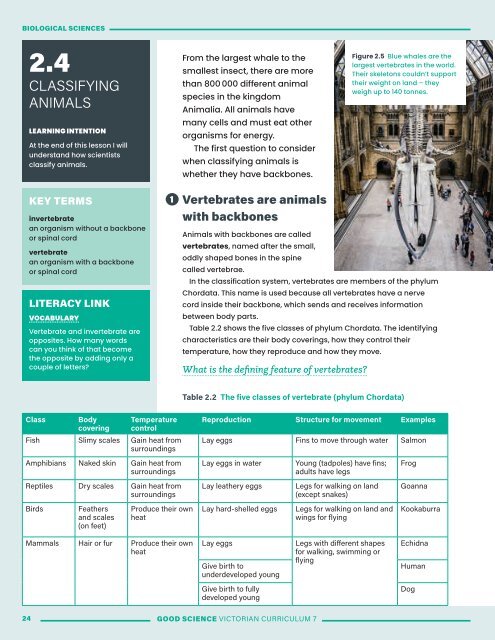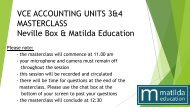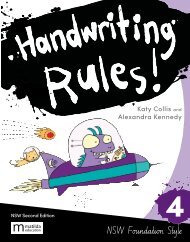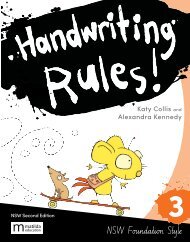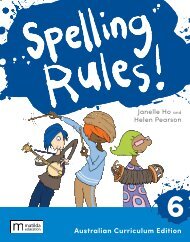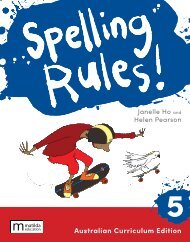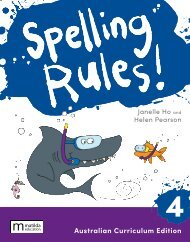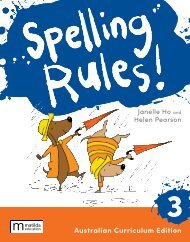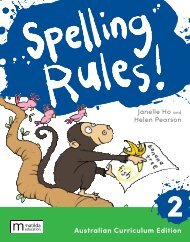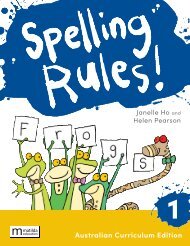Good Science Victorian Curriculum Year 7
Digital sample of Matilda's newest publication, Good Science Victorian Curriculum Year, authored by Emma Craven and Aaron Elias. For more information visit www.matildaeducation.com.au or email Katrina Tucker, katrinatucker@matildaed.com.au
Digital sample of Matilda's newest publication, Good Science Victorian Curriculum Year, authored by Emma Craven and Aaron Elias. For more information visit www.matildaeducation.com.au or email Katrina Tucker, katrinatucker@matildaed.com.au
You also want an ePaper? Increase the reach of your titles
YUMPU automatically turns print PDFs into web optimized ePapers that Google loves.
BIOLOGICAL SCIENCES<br />
2.4<br />
CLASSIFYING<br />
ANIMALS<br />
LEARNING INTENTION<br />
At the end of this lesson I will<br />
understand how scientists<br />
classify animals.<br />
From the largest whale to the<br />
smallest insect, there are more<br />
than 800 000 different animal<br />
species in the kingdom<br />
Animalia. All animals have<br />
many cells and must eat other<br />
organisms for energy.<br />
The first question to consider<br />
when classifying animals is<br />
whether they have backbones.<br />
Figure 2.5 Blue whales are the<br />
largest vertebrates in the world.<br />
Their skeletons couldn’t support<br />
their weight on land – they<br />
weigh up to 140 tonnes.<br />
KEY TERMS<br />
invertebrate<br />
an organism without a backbone<br />
or spinal cord<br />
vertebrate<br />
an organism with a backbone<br />
or spinal cord<br />
LITERACY LINK<br />
VOCABULARY<br />
Vertebrate and invertebrate are<br />
opposites. How many words<br />
can you think of that become<br />
the opposite by adding only a<br />
couple of letters?<br />
1<br />
Vertebrates are animals<br />
with backbones<br />
Animals with backbones are called<br />
vertebrates, named after the small,<br />
oddly shaped bones in the spine<br />
called vertebrae.<br />
In the classification system, vertebrates are members of the phylum<br />
Chordata. This name is used because all vertebrates have a nerve<br />
cord inside their backbone, which sends and receives information<br />
between body parts.<br />
Table 2.2 shows the five classes of phylum Chordata. The identifying<br />
characteristics are their body coverings, how they control their<br />
temperature, how they reproduce and how they move.<br />
What is the defining feature of vertebrates?<br />
Table 2.2 The five classes of vertebrate (phylum Chordata)<br />
Class<br />
Body<br />
covering<br />
Temperature<br />
control<br />
Fish Slimy scales Gain heat from<br />
surroundings<br />
Amphibians Naked skin Gain heat from<br />
surroundings<br />
Reptiles Dry scales Gain heat from<br />
surroundings<br />
Birds<br />
Feathers<br />
and scales<br />
(on feet)<br />
Produce their own<br />
heat<br />
Reproduction Structure for movement Examples<br />
Lay eggs Fins to move through water Salmon<br />
Lay eggs in water<br />
Lay leathery eggs<br />
Lay hard-shelled eggs<br />
Young (tadpoles) have fins;<br />
adults have legs<br />
Legs for walking on land<br />
(except snakes)<br />
Legs for walking on land and<br />
wings for flying<br />
Frog<br />
Goanna<br />
Kookaburra<br />
Mammals Hair or fur Produce their own<br />
heat<br />
Lay eggs<br />
Give birth to<br />
underdeveloped young<br />
Legs with different shapes<br />
for walking, swimming or<br />
flying<br />
Echidna<br />
Human<br />
Give birth to fully<br />
developed young<br />
Dog<br />
24 GOOD SCIENCE VICTORIAN CURRICULUM 7


